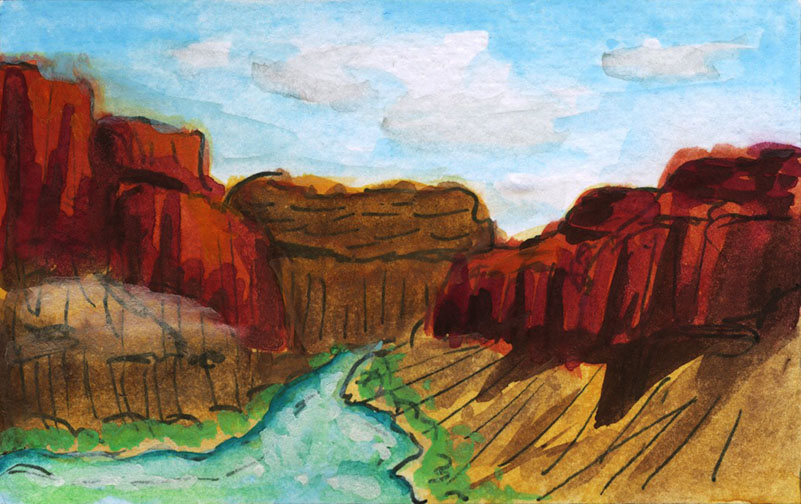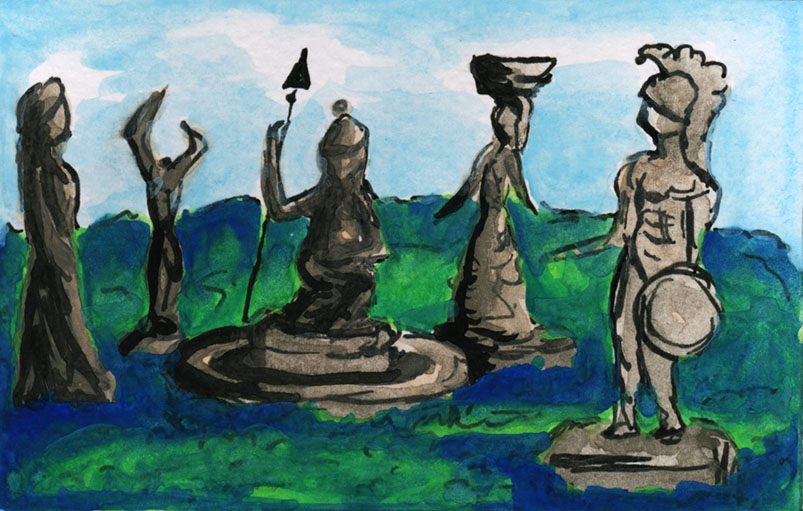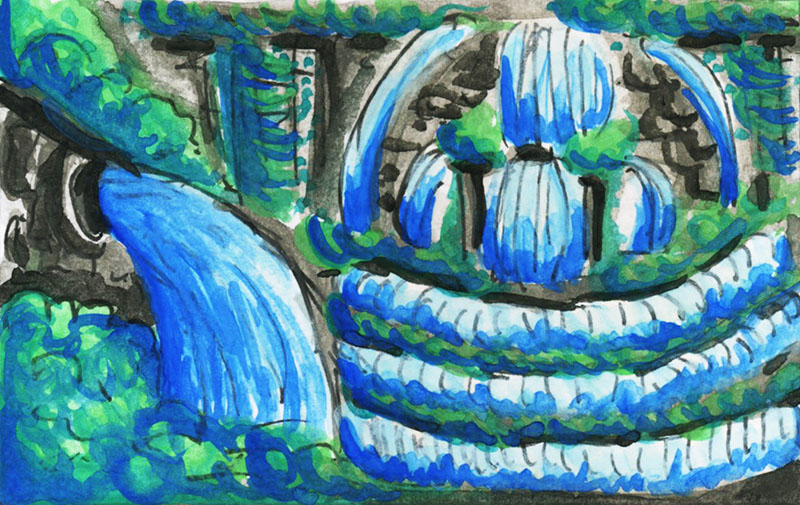For Aristotle, poetry was a “medium of imitation.” For Wordsworth, it was “emotion recollected in tranquility.” Among the thousands of definitions of what is certainly one of the western culture’s oldest art forms, one of my favorites is by the 19th-century Romantic essayist William Hazlitt. In his essay “On Poetry in General,” Hazlitt defined poetry as “the language of the imagination and the passions.” One doesn’t have to be a Romantic to understand what he was talking about — Coleridge’s “Kubla Khan,” Arnold’s “Dover Beach,” and Hart Crane’s “Voyages” are proof of what the imagination and the passions are capable of when working at a fever pitch.
Reduced to its most basic level poetry is words, spoken or printed. But that could just as well be a description of a newspaper. As Hazlitt says, imagination and passion are integral to poetry. Put in slightly different terms, poetry is the emotion of sensitive souls born in the imagination and expressed in the language of the heart. Good poems are as compressed as a diamond (Poe’s “To Helen”) or as expansive as a supernova (Dante’s Divine Comedy). Either way, they illuminate private moments and translate them into universal ones. Poetry unlocks deeper insights into what it means to be human.
Here is Hazlitt again:
“. . . the poetical impression of any object is that uneasy, exquisite sense of beauty or power that cannot be contained within itself; that is impatient of all limit; that . . . strives to link itself to some other image or kindred beauty or grandeur.”
So, if Hazlitt is right (and I think he is), poetry is not limited to words. It can be a place. The Grand Canyon is Nature’s poetry at its most dramatic, linking us to the mystery of creation itself. The Lincoln Memorial in Washington, D.C. is not only a marble statue but a symbol that calls to mind our nation’s bloody attempt at suicide and the murder of its president. Poetry can be a moment in history, like Hiroshima, that first atomic flash of awareness that the extinction of the human race lies within its own hands. Or it can be that puff of dust rising into the airless environs of space as Neil Armstrong’s boot touched down on the surface of the moon. That moment wasn’t just Man on the moon, as momentous as it was; it was Mind into the universe. Like poems, places too, have the power to speak to our deepest emotions.

20 miles outside of Rome on the western slopes of the Sabine Hills, is the small town of Tivoli. A combination of ancient monuments, medieval landmarks, and Renaissance landscaping, Tivoli has been a summer retreat since the days of the republic. The poets Horace, Catullus and Propertius, and Augustus himself, went there to escape the poison-and-dagger-politics of ancient Rome. Modern-day travelers go in flight from Roman drivers, 21st-century charioteers who make the chariot race in the movie Ben-Hur seem like a carnival ride. But Tivoli is more than a respite from the noise and bluster of Rome. It is home to the magnificent Villa d’Este and its mystical Tivoli Gardens.
In the 1550s Cardinal Ippolito d’Este, son of Lucrezia Borgia, the illegitimate daughter of Pope Alexander VI and sister of the even more infamous Cesare Borgia, failed in his fifth and final try at becoming pope. Instead of retreating into a shell to lick his wounds he withdrew to a family estate at Tivoli. Highly cultured and wealthy to a degree that was, at best, incongruous with the teachings of the Church whose founder saved his kindest words for the poor, the cardinal now felt free to devote himself to what had always been his first passion: art. As a consolation prize for his failure to win St. Peter’s Chair, Pope Julius III made Ippolito governor of Tivoli and gave him an abandoned monastery to live in. With his newfound temporal power and his vast personal wealth, Ippolito set about realizing his dream — bringing back to life the classical age of Rome in the form of an ancient Roman garden.
But this was to be no ordinary garden of flowers, trees, terraces, and fountains. What Ippolito wanted was a garden worthy of the ancient Roman nobility, of powerful senators, rich princes and of Roman emperors themselves. He took for his model the garden of Hadrian, the ruins of which 17 miles away were to provide many of the statues and architectural features that ultimately graced Ippolito’s garden. More than anything else, the Villa d’Este and its garden were to be a product of the imagination, a place of mysticism, fancy and even of a touch of wizardry. In his choice of the person to make it all happen, the cardinal found his wizard.
Pirro Ligorio was a painter, architect, landscaper, and antiquarian. More importantly, his deep knowledge and love of antiquities were the perfect tools for him and his landscape-artist Alberto Galvani to create Ippolito’s dream garden. Ligorio decided that the best way to re-create a classical Roman garden was to link it to a still-living piece of Roman history. For that piece, he chose the Metamorphoses of Ovid, an epic poem of 12,000 lines. In over 250 tales, Ovid brought to life the world of Greek mythology — a world of gods and goddesses lusting for each other and for mortals (Apollo and Daphne), of daring and death (Icarus), of greed (Midas), of supernatural feats of strength (Hercules), of Castor and Pollux, Proserpine, Venus, Pygmalion and hundreds of other mythological figures. Published in 8 A.D., the poem was an immediate success with the Roman public. It has served as a boundless wellspring for western art and literature ever since.

But the Metamorphoses (Changes) is not just a collection of fanciful tales about mythological figures indulging in rampant debauchery, playing tricks on unsuspecting mortals or exacting revenge for perceived offenses against them by mortals or their fellow gods. The underlying theme of the poem is how emotions, or passion, have the power to change the world, including gods, humans, animals, even inanimate objects. Apollo’s lust changes him into a would-be rapist of Daphne, who is saved at the last moment by being turned into a tree by her mother, the goddess of Earth. Twin half-brothers, Castor and Pollux, are turned into stars and become the patrons of sailors. Hercules is changed into a god and, later, into a constellation in reward for choosing virtue over vice. Even objects undergo change — Aeneas’s ships into sea nymphs, mushrooms into human beings and smoke into birds.
Ligorio’s genius was to design a garden where surprise, shock, or an encounter with the unknown would demonstrate how emotions bring about change. In the center of the garden is its famous Fountain of the Dragon. The four dragon-head spouts are set in an architectural cave at the top of a difficult-to-climb staircase, symbolizing the 12 Labors of Hercules imposed on him by the gods. A fork in the staircase represents the choice Hercules faced as a youth between a life of vice and pleasure or one of hard work and honor. That fork leading up to the fountain forces visitors to make essentially the same choice: one way leads to a statue of Diana, the goddess of fertility and chastity (virtue), the other to a statue of Venus, goddess of unbridled love and physical beauty (vice).
In another tale from the Metamorphoses, Aeneas wanders from one surprise to another in his journey back from Troy. Visitors to Tivoli Gardens echo his journey, constantly having to choose among various pathways through the garden. One path ends at a temple façade in honor of Diana, adorned with a statue of the goddess from whose numerous breasts, symbolic of abundance, flow streams of water. Down another is a miniature version of the city of Rome. Still, another leads to the fountain of Neptune with its amazing water-organ where a mechanism inside the fountain, controlled by air pressure and flowing water, creates notes similar to that of an organ. Talk about wizardry!
The most impressive feature of Tivoli Gardens is the water, itself a timeless symbol of change and rebirth. Placed throughout the eleven acres are 51 distinct fountains, 398 spouts, 60 pools of water, 364 water jets, 64 waterfalls, a symphony that splashes, trickles, courses down and around causeways, gurgles over stones and pours out of waterspouts in some of the most incredible demonstrations of moving water ever seen. It is Coleridge’s “water, water, everywhere” 250 years before he was even born! The villa’s Avenue of 100 Fountains, meant to symbolize the aqueducts of Rome, is a corridor of 300 fountain spouts in three levels. As you walk it, you half-expect to reach the end of the corridor and come face-to-face with the worldly cardinal himself. No matter which way they turn, visitors find themselves transported back 2,000 years to a world where gods, fauns, satyrs, nymphs and humans interacted spontaneously.
It doesn’t take specialized knowledge of history or gardening to appreciate the beauty of the Villa d’Este and its gardens. To the eye, it’s a visual masterpiece. But awareness of Greek mythology or Roman civilization opens the visitor to the feeling that something is going on that’s more than just fancy landscaping, that there is more here than meets the eye.

I have been to the Villa d’Este twice. Both times I have been acutely aware of the “vibes” that emanate from the place. Determined to gain a better understanding of what I was experiencing, I came across a book, What Gardens Mean, by Stephanie Ross. In her discussion of the emblematic tradition in the art (where one thing suggests another) and how it translates into the world of gardening she writes:
. . . the emblematic tradition integrated references to classical culture, the Bible, and more primitive lore and superstition. Together these sources provided a wealth of character and incident whose significance would have been instantly recognized by “cultured” people — those who formed the audience for the arts of painting and poetry; furthermore, because the emblematic tradition assigned conventional significance to particular visual images, it could be transferred to the art of gardening. Using a combination of resources—inscriptions, sculpture, architecture, plants, even topography—a garden designer could recreate an image from an emblem book or highlight certain elements whose significance would be immediately appreciated. This explains one way in which gardens, in the absence of alphabet, syntax, and grammar, could convey meaning.
Thus for centuries, looking at a garden, like looking at wild nature, would immediately bring to mind numerous poetic references and images. The garden was no longer an inert object. Through the medium of poetic imagery, the garden was given new levels of meaning and mediums of expression. It was as if the garden had been given a voice and, waxing unabashedly romantic here, with that voice could sing.
Here was the perfect explanation of how Ippolito’s garden and its “numerous poetic references and images” had been speaking to me. In a literal sense, Tivoli Gardens is a beautiful garden. In a metaphoric sense, it’s a poem. For me, a walk through the grounds of the Villa d’Este is the same as reading Tennyson’s “Ulysses ”or looking out on the white sea of grave markers in Arlington Cemetery or listening to Luciano Pavarotti singing “Nessun Dorma.” These experiences are not just ink on a page or crosses in a cemetery or a song; they are the “exquisite sense of beauty or power that cannot be contained within itself.” They are poetry no less than is Milton’s Paradise Lost or Shelley’s Adonais.
Most poems, certainly all good ones, are journeys of a sort. In Hart Crane’s “The Bridge,” the Brooklyn Bridge is a symbol of America’s mythic journey and the optimism it embodies for the human race. In The Divine Comedy, Dante travels through hell and purgatory experiencing fear, wonder, sorrow, joy, regret, elation, disgust, the full range of emotion, before meeting Beatrice who leads him to heaven and his salvation.
The Villa d’Este and its mystical garden is a similar journey, but not one that leads forward to salvation. This is a journey back to a pagan world where sin doesn’t exist and there is no need for redemption. There are no signs of Christianity in Tivoli Gardens — no cross, no mention of Christian martyrs, no statues of St. Francis. It’s almost as if the worldly cardinal believed that by bringing Roman mythology back to the life he could help make amends for the wanton destruction of pagan artworks and temples that accompanied the triumph of Christianity.
Like Shakespeare’s Hamlet, the Lincoln Memorial, and Mankind’s first touch of a terrestrial body that wasn’t Earth, Tivoli Gardens and the Villa d’Este is “the language of the imagination and the passions,” a living example of the poetry of place. •




